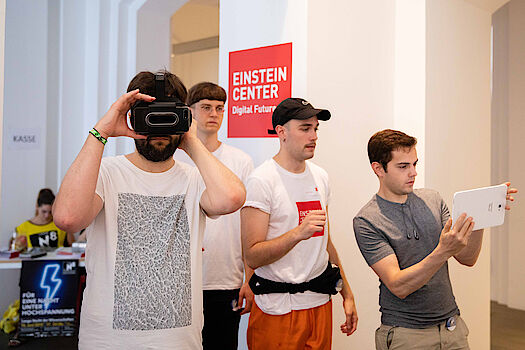Around 300 guests visited the Einstein Center Digital Future (ECDF) during the Long Night of the Sciences (LNDW) 2019. In the House of Digitalization, visitors experienced music-making trees, virtual Red Cross missions, electronic textiles, intelligent control of water networks and much more. Until midnight, professors offered hands-on research.
How could energy be saved in residential areas? Visitors to Prof. Dr. Sergio Lucia's stand are looking into this question. On a screen, they build their own smart neighbourhood and consider how many batteries, photovoltaic systems or gas heaters should be used. "More than 30 teams have built their smart neighbuorhood with me. It was a great opportunity to discuss together and see how complex the problem is and how different factors like real weather data or the type of building affect the best possible smart neighbourhood," he says.
Prof. Dr. Andrea Cominola deals with the intelligent control of water networks. He has installed sensors in a laboratory at the TU Berlin. They measure various parameters such as pressure, flow and vibrations. This data is transferred to ECDF in real time and shows how the condition of pumps and other components of a water network can be monitored in real time. "Visitors were very interested in learning more about the technological and social implications of my research. I was very impressed with how many different people came to visit the ECDF. I am very pleased that citizens have such opportunities to engage with research and science," he says.
Prof. Dr. David Bermbach points to an interactive map of Berlin. "Here you can see thePaulsborner Straße in Halensee. As you can see, cyclists are often overtaken very closely at this point," he explains. The map is part of the research project "SimRa - Safety in Cycling". Using a specially developed smartphone app, the researchers collect data on near misses. "Of course, we also have to collect and evaluate further data for the Paulsborner Straße in order to be able to make scientifically reliable statements," says Bermbach. He and his team are enthusiastic about the LNDW: "We had a lot of interest and met with great curiosity. I am curious to see how many new users we have been able to attract."
A visitor pulls a pleated fabric apart and folds it up again. Sounds then can be heard via loudspeaker. Prof. Dr. Berit Greinke brought various patterns of textile pleated sensor technology to the LNDW. The professor for wearable computing shows how the processed sensors can react to touch and deformation. "The visitors were diverse and asked exciting questions. The LNDW was a great opportunity for me to receive initial feedback," says Berit Greinke.
Fashion design students at the UdK have been dealing with utopias of digital corporeality. Among other things, they dealt with the following questions: How can digital identity be a way of reflecting on bodies and clothing? What are the capabilities of the digital body beyond the human body? What would beif there were no physicality in the future?
A drum set sounds from a room. But there is no instrument to be seen when entering. Instead, a plant stretches out its leaves. The visitors inside tap on the individual leaves and make music. This "instrument" was developed by Prof. Dr. Daniel Hromada. He is Professor of Digital Education at the University of the Arts. With the various educational artefacts such as the digital primer or the drum tree, he breaks new ground in knowledge transfer. "A few years ago, I took part in the French version of the LNDW in Paris and until Saturday I didn't know that the LNDW also played a very important role in Berlin. The number of visitors who came to our House of Digitalization surprised me very positively. I was most pleased that there were also a few children among the visitors who tested my 'freshly baked' digital primer – an artifact that combines electronic paper with contactless interaction – and they enjoyed it," Hromada reports.
In the Micro Factory next door, the 3-D printer is humming. Here, red plastic is used to create wristbands that visitors are allowed to take with them. Friedrich Schmidgall, head of the Micro Factory, stands at the laser cutter and puts new sheets of paper into the machine. For the LNDW he designed a cube with the ECDF logo, which is cut out by the laser cutter. "The visitors were very impressed. The children in particular enjoyed seeing the machines in action," says Schmidgall.
The guided tours of the Future Security Lab are otherwise reserved for specialist groups only. At the LNDW, the team from the Forschungsforum Öffentliche Sicherheit, gave insights into current security research in Germany. They presented a demonstrator that is used to involve volunteers in crisis situations. With virtual reality glasses, the visitors experienced a sighting exercise of the German Red Cross. A simple labyrinth game contributed to the understanding of meaningful emergency exit signage. "We were very pleased about the interested visitors. Many discussed with us topics such as data protection, anonymous images and sensor technology and the associated complex problems," reports Helga Jäckel from the Future Securty Lab.
Cornelius Hutfless and his team take the visitors inside into various virtual rooms: a theatre, a football stadium, a church or a mosque. This is made possible by the "CuCube" augmenting reality app. The users can switch on an individual, visual and acoustic scenario via AR glasses and headphones, but continue to see all users inside the room within their own AR projection. People with different lifestyles are brought together through this community experience.
The next Long Night of the Sciences will take place on Saturday, June 6, 2020.

